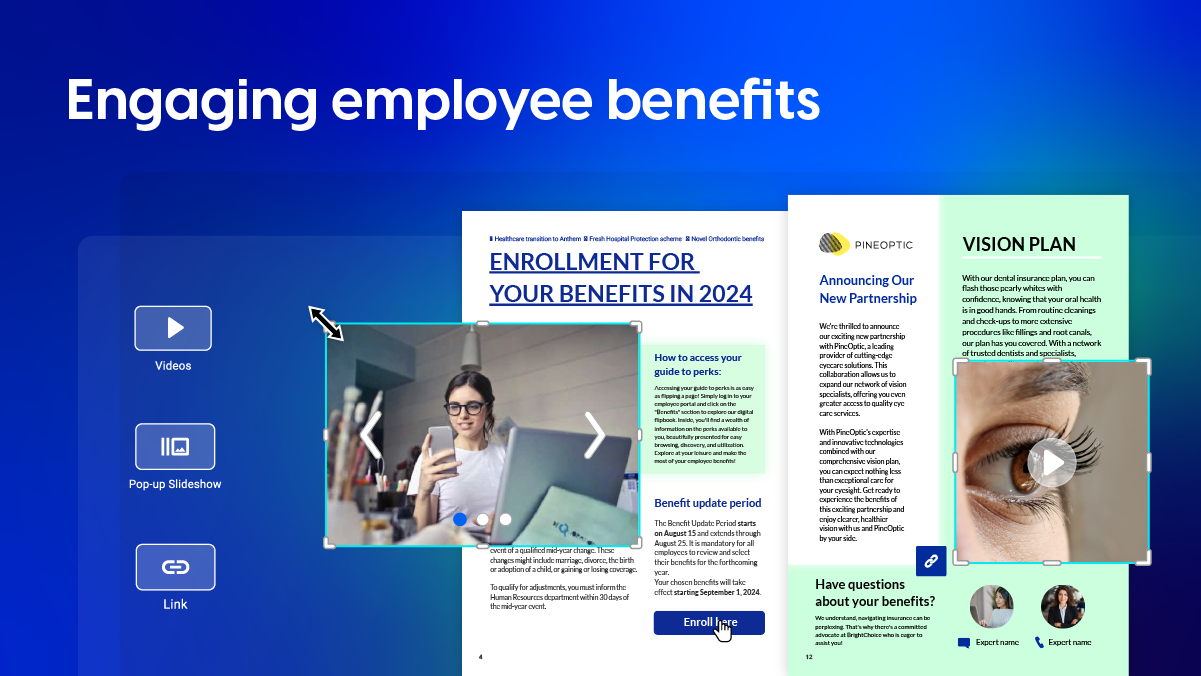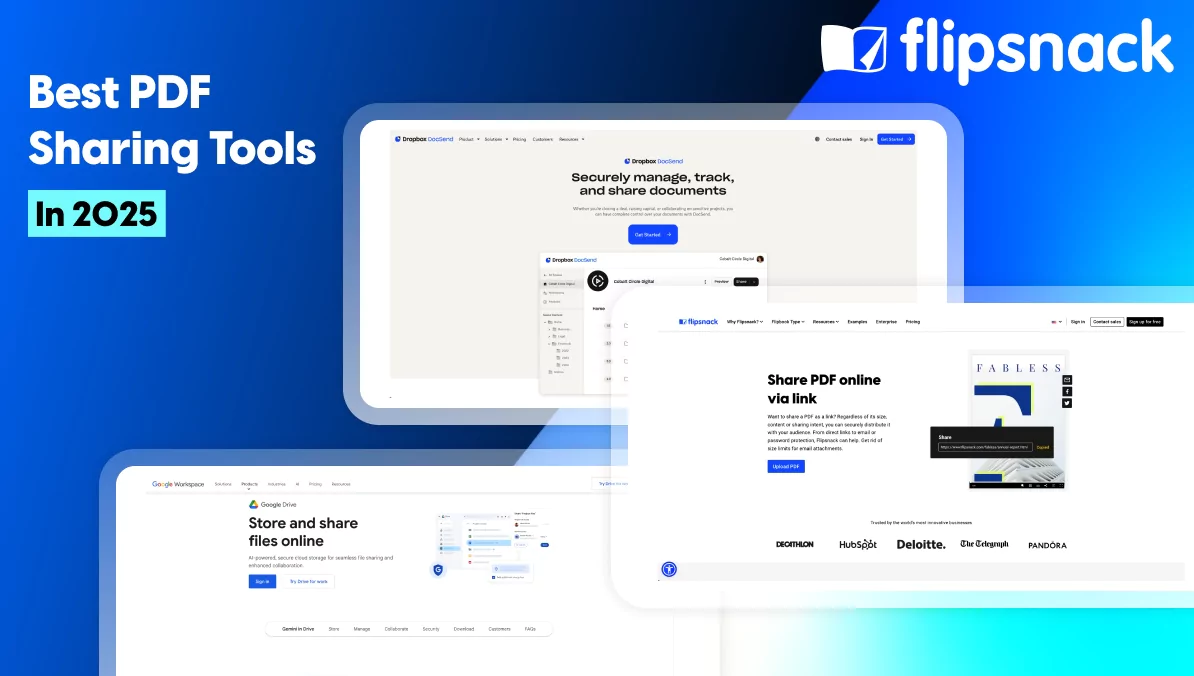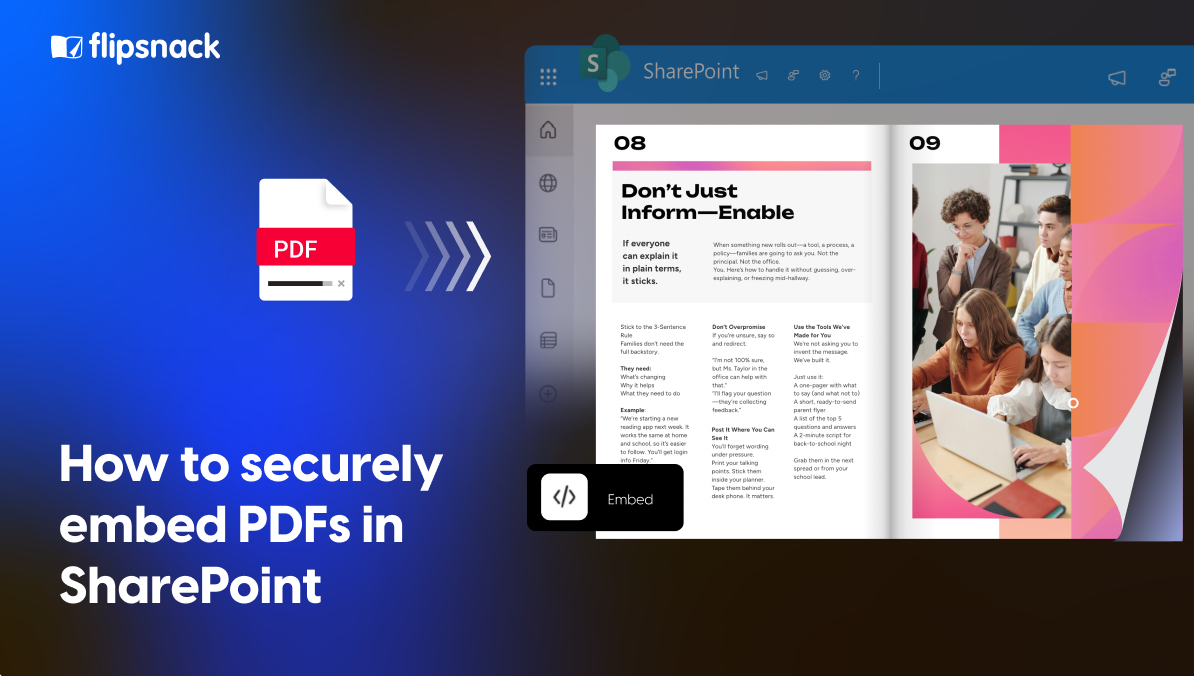How to create more engaging employee benefit guides
The significance of a dynamic employee benefits guide is increasingly recognized in the competitive realm of insurance brokers. Employee benefits guides are transitioning from static booklets created in Word or PDF that are a struggle to continuously update to dynamic, interactive experiences that communicate benefit packages more clearly.
Interactive employee benefits booklets and brochures that incorporate multimedia elements like videos, infographics, and clickable content not only make information more accessible but also more engaging. Secure digital distribution makes it possible for insurance brokers or advisors to efficiently share critical information, such as health coverages and detailed policies, while analytics help track user engagement to refine guides for the future of work.
Table of contents
Here, we’ll explore how insurance brokers can leverage digital guides to transform employee benefits guides into valuable assets that can be molded to fit changing workforce trends. We’ll show you how to achieve this by incorporating key elements into the overall communication strategy and providing benefits packages to your clients that can be easily edited and customized to fit various needs.
Understanding the audience
The modern employee’s profile has changed significantly. Nowadays, flexible work hours, hybrid or remote work, student loan repayments, and improved work-life balance top their demands. Finding the right benefits reduces workplace stress and burnout, and employers can mitigate any drawbacks through employee time-tracking software or software designed for remote work management. Additionally, many businesses are now implementing payroll software that makes it easy to create pay stub documents, simplify salary distribution and ensure timely and accurate payments.
Insurance brokers need to offer an extensive variety of benefits that highlight the market needs for their customers. However, the current needs go beyond a basic list of benefits. Companies want engaging, personalized access to well-organized information for their employees during enrollment so changes to existing plans can be easily implemented based on different employee needs. Any corrections, or updates of information can be implemented and saved in the same digital flipbook, without needing to send a new document to everyone involved. The employee benefits shared online with clients or employees will maintain their accuracy and remain in the same link.

Digital benefit guides offer personalized, interactive content, miles away from generic, text-heavy past brochures. Complex benefits information is simplified, improving understanding of different plans included in the package. These guides meet modern workforce needs, enhance internal communication strategies, and encourage informed decision-making. Employees who understand their options can choose which benefits they want to enroll in during the open enrollment period, leading to a happier company culture.
The challenge is to make these guides as valuable as the detailed benefits. By doing so, companies can enhance the employee experience, fostering a more engaged and satisfied workforce.
Key elements of engaging digital employee benefits guides
Creating an engaging digital benefits guide is a vital task for successful insurance brokers. The reason for that is that these employee benefits guides are difficult to understand, leading to 2 in 5 employees being unable to decipher the communication sent by their employer, healthcare vendor or insurance advisor. An effective benefits guide needs to inform first and foremost seeing as 53% of business’ annual healthcare spending goes to waste due to confusion.
Employees often don’t understand the language, look at their benefit packages only when a situation arises and 91% of them choose the same plan annually as it’s the easiest way to go. So how can insurance brokers fix these issues? By making the complex world of employee benefits interactive, accessible and understandable. Here are seven key elements to consider when creating an engaging digital benefits guide:
1. Incorporation of digital elements
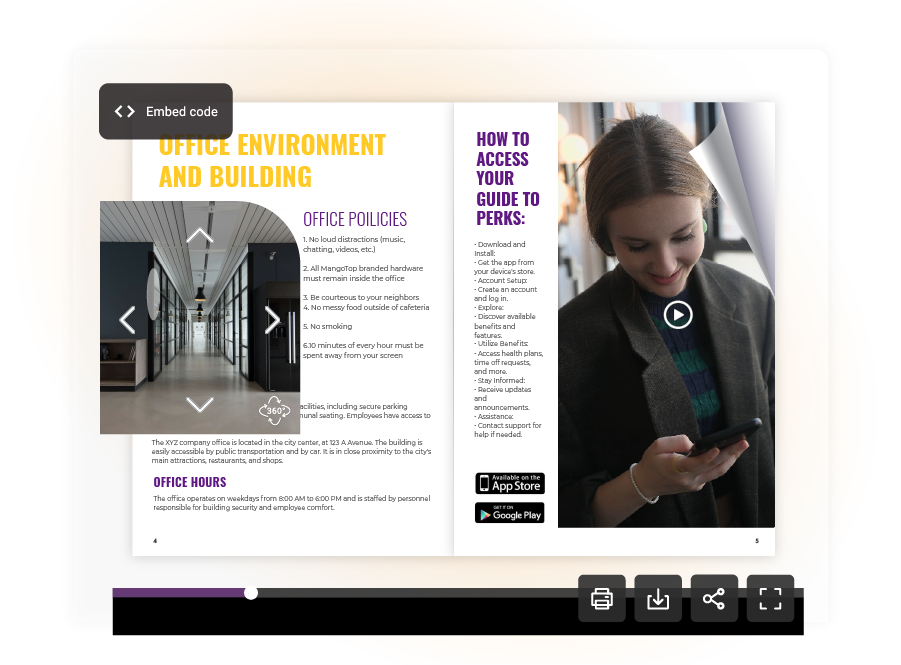
Digital employee benefits guides can incorporate multimedia features such as videos and interactive tools, making them more engaging and easier to navigate. Links and search functions enable decision-makers to quickly locate the information they need, significantly enhancing the user experience and making the guide a versatile, user-friendly resource.
We’ll go into how to implement these digital elements and, more importantly, how to continuously use them to improve these guides later on. Firstly, let’s swiftly go over them and how they can be used:
- Hyperlinks—Improve employee benefits guide navigation through internal go-to-page links that allow users to reach the desired section of the guide with one click. In contrast, external links help create connections to additional information, platforms for health benefits or communication, or other relevant websites.
- Multimedia elements—Enhance the visual experience through images, videos, or slideshow uploads without overcrowding the document or taking up too much space.
- Embeds—Bridge the gap between expectations and reality by including embedded maps, virtual tours, or hosted videos within the employee benefits guide.
- Forms—Add feedback forms or surveys to measure how these guides are received. This will help your customers implement data-driven optimization strategies and resolve potential engagement issues within their workforce.
- Pop-ups—Use pop-ups to provide additional details related to information that may otherwise take up too much space within the employee benefits booklets in a more structured, engaging, and interactive way.
2. Prioritize information
Not all information is created equal. Some details are more important and impactful than others, and these should be presented first. This approach, known as the inverted pyramid, guides the reader towards the most important points first before moving on to secondary details and then to general background information. This way, you ensure the most crucial information isn’t lost in the shuffle.
Organizing this information within employee benefits guides can lead to stuffy documents, but it doesn’t have to. Using some of the interactive elements mentioned above can limit the space each informative section takes while also ensuring you don’t have to overlook important details.
3. Repetition of key points
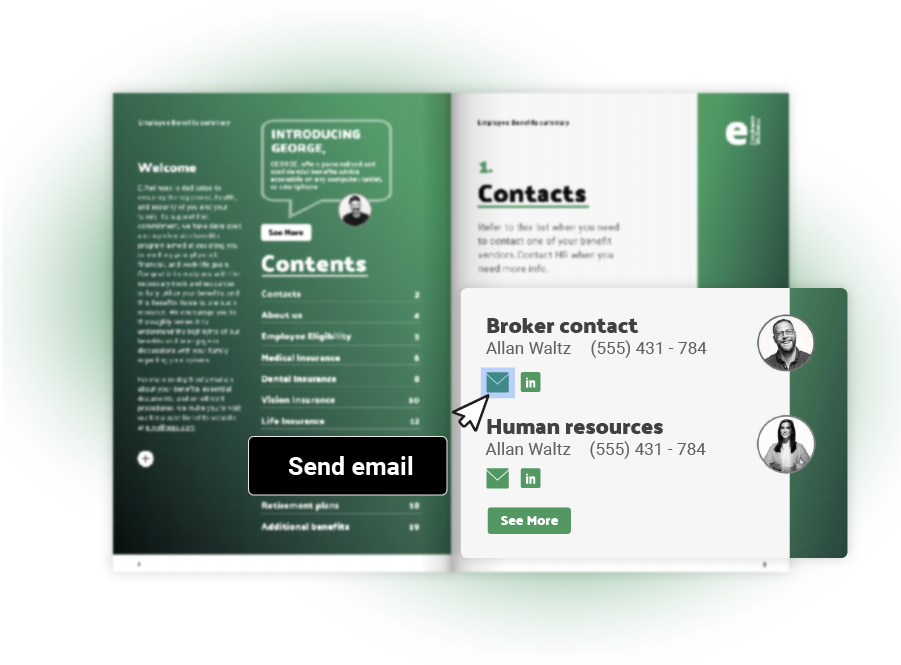
Repetition is a fundamental principle of effective communication, especially regarding complex or essential information. Important details such as open enrollment period dates, changes to benefits programs, and details about benefits engagement tools should be repeated in various sections of the guide. This repetition helps ensure HR teams do not overlook crucial information and reinforces their understanding of key points.
Ensure all communication channels are included in the employee benefits guides to connect insurance consultants with their beneficiaries and retain their engagement. While the information in these files is essential during the onboarding process of new employees, even if using recruiting CRM software, they remain relevant with the necessary links to social media pages, communication tools, or information about how these perks can be accessed.
What use are perks and benefits if HR teams don’t understand them and the necessary interconnectivity isn’t provided? Create comprehensive digital employee benefits guides that clients and their employees can refer to whenever they need clarifications.
4. Clear and organized visuals
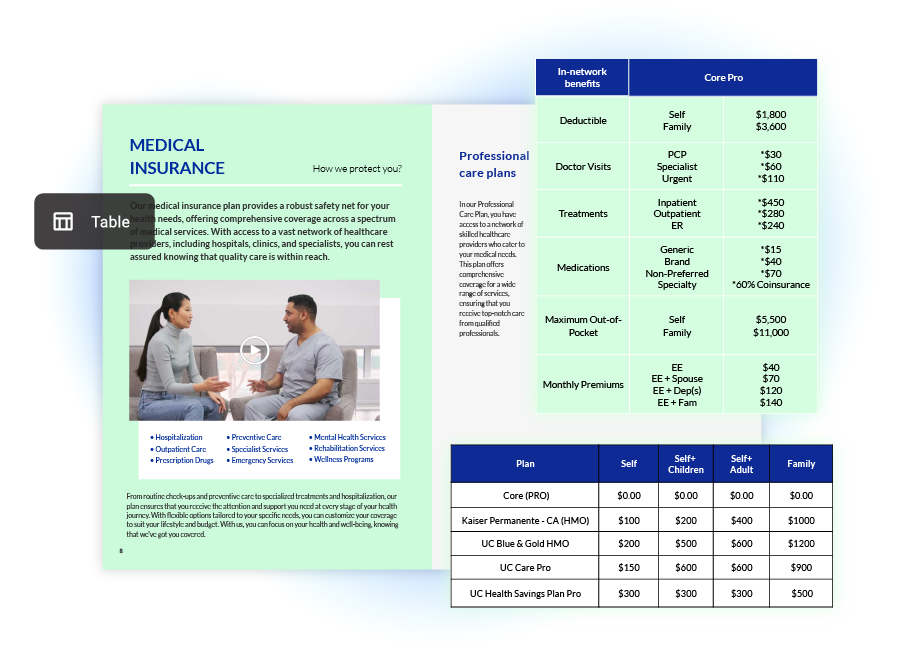
A picture is worth a thousand words, and this holds true even in a benefits guide. Graphs and other visual elements should be simple, clear, and easy to understand. They help your potential clients visualize their capacity of limiting budget, the trade-offs between different benefits options, and other complex aspects of their benefits package. Simplifying complicated concepts into easy-to-understand visuals increases comprehension and retention of information.
Employees should understand how their benefits plan affects costs for hospital visits or unexpected medical tests and which doctors are covered. They also need to know how a health savings account can help them financially now and in the future. Including charts, tables, and graphs breaks up text-heavy content and provides a quick, at-a-glance understanding of data like premium costs, coverage comparisons, and deductible impacts. Using these visuals effectively demystifies details about healthcare plans, retirement savings growth, and more, making the guide more engaging and useful for decision-making.
5. Customizing employee benefits
A one-size-fits-all approach doesn’t work when it comes to benefits communication. The guide should include several scenarios showing which benefits plans might be the best choice for different situations. For example, a young, single employee will have different needs and priorities than an older employee with a family. While young parents appreciate benefits like on-site daycare centers, adventurous employees will appreciate the option to work remotely full-time; likewise, fitness enthusiasts will appreciate an array of nutritious snacks and healthy water brands. In this way, employees with different needs can choose the benefits and perks they want during the open enrollment period.
By providing personalized guidance, you help employees understand the best options for their unique circumstances. Take the time to understand different experiences to help customers attract and retain top talent who are engaged, motivated, and productive. Address these aspects based on individual customer needs and be supportive of their differences. If changes come up once the employee benefits guide is shared, simply make the changes in the flipbook. Anyone who already had access to that guide will see the updated version saving you the trouble of having to explain each correction or slight change in benefit plans.
6. Professional design
First impressions matter, and professionally designed employee benefits guides can make a powerful positive impact. A sleek, clean, and visually appealing guide not only engages the reader’s attention but also enhances readability and ease of navigation. It’s not just about aesthetics; a well-structured guide with clear headings, bullet points, and organized sections can enhance the overall browsing experience and make it easier to find the needed information. Additionally, a well-organized structure improves accessibility ensuring that the content will be accessible to all.
Use professionally ready-made employee benefits templates to help optimize the production process while significantly enhancing engagement and effectiveness. They can provide a visually appealing and well-structured foundation as inspiration, ensuring that the crucial information is not only presented clearly but also in an engaging way. Why start your design work from scratch every time when you can simply edit the content to fit particular needs? The flexibility to customize these employee benefits guide templates allows insurance brokers to tailor the content specifically to customer needs, reflecting their unique brand identity and the specific benefits they offer.
Creating an engaging digital benefits guide involves carefully balancing content, design, and strategy. It requires putting oneself in the reader’s shoes, understanding their needs and preferences, and delivering information in a way that is engaging, accessible, and meaningful. It’s not an easy task, but the rewards—a well-informed and appreciative workforce—are well worth the effort.
Measuring success and gathering feedback
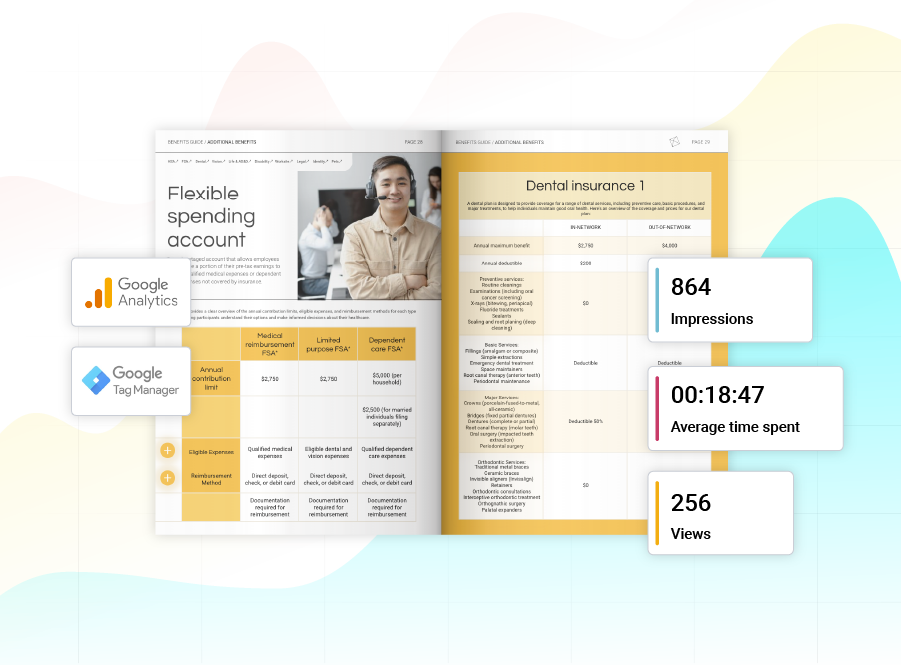
To optimize engagement with benefits materials, it’s crucial to measure and analyze how these documents are used. Here’s a structured approach to achieving this through advanced analytics and feedback mechanisms:
1. Comprehensive tracking of engagement metrics
Monitoring key metrics such as views, clicks, and downloads provides a fundamental understanding of how often and in what ways the benefits materials are accessed. This reveals which sections garner the most interest and which may require more clarity or enhancement. Additionally, tracking device and location data helps identify the accessibility and usability of the content across different platforms, guiding optimizations for various viewing experiences.
2. Individual and aggregate user engagement statistics
Monitoring individual user interactions with the guides can tailor communications and follow-ups, providing personalized assistance or additional resources to clients who may spend less time on important sections. Analyzing overall engagement trends across the organization allows employee benefits teams to assess the effectiveness of the communication strategy and identify common drop-off points or highly engaged sections. This data provides information about both immediate adjustments necessary and long-term strategies that will benefit communications.
3. Feedback collection and actionable insights
Incorporating direct feedback mechanisms within the documents, such as feedback forms, enables real-time, actionable insights from the users themselves, amplifying employee voice and helping to understand what HR teams find helpful and where they struggle. Highlighting achievements through employee recognition software can further support employee engagement by showing appreciation for contributions while aligning with the feedback collected. Utilizing trackable links can reveal the specific interests and needs of different segments within the workforce, improving the relevance of the materials and enhancing the personalization of outreach efforts.
4. Integration with advanced analytics tools
Connecting analytics tools like Google Analytics or Google Tag Manager with benefit guides provides a deeper dive into user behavior and more sophisticated data analysis. This includes tracking the duration of interactions, bounce rates, and pathways through the content, offering a granular view of engagement that can significantly influence the effectiveness and reach of benefits communications.
By systematically tracking and analyzing these aspects, organizations can continuously refine their employee benefits guides. This detailed approach ensures that benefits communications are not only informative but also engaging and responsive to the needs of the workforce.
How can I create engaging employee guides in Flipsnack?
Producing an engaging digital benefits guide is essential for insurance brokers, as it enhances employee understanding and engagement by making complex benefits information accessible and comprehensible. Here’s a concise guide on using Flipsnack to elevate your employee benefits communications:
- Upload your PDF document: Log into Flipsnack, upload your employee benefits documents, or start from scratch. Depending on your specific needs, you can merge multiple documents into one comprehensive digital flipbook or keep them as individual files.
- Enhance engagement: Use our Design Studio to transform static documents into interactive experiences. Embed videos, add hyperlinks, and interactive elements using simple drag-and-drop functionality to make your guide more engaging and user-friendly.
- Customize and brand: Tailor your publication to reflect your client’s brand by integrating logos, selecting appropriate fonts, and brand colors. This not only enhances aesthetic appeal but also strengthens brand consistency and trustworthiness.
- Select publishing options: Choose how to publish your guide, from public accessibility to more restricted settings like password protection or limited sharing through SSO, ensuring accessibility and security.
- Distribute and analyze: Share your guide via links, email, or secure sharing options. Leverage Flipsnack’s analytics to track user engagement, view counts, and time spent on documents, allowing you to optimize future publications based on measurable insights.
Streamline the creation of benefits guides and significantly improve their effectiveness through Flipsnack. By integrating interactive elements, consistent branding, and monitoring engagement through robust analytics, these guides become more than just informational—they actively engage and inform. Isn’t it crucial, then, to adopt such innovative tools to ensure our communications are as effective as possible? This strategic approach not only delivers crucial benefits information but also boosts overall employee satisfaction and understanding.
Closing thoughts
In the rapidly evolving landscape of human resources, transforming traditional employee benefits guides into dynamic, interactive tools is essential. This shift from static PDFs to engaging digital platforms makes information more accessible and enticing through interactive elements, videos, and clickable content. Furthermore, the use of analytics to track interactions with your documents offers insights that enable continuous improvement of these communication tools, making them more effective and relevant.

It is crucial for insurance companies and HR departments to leverage digital innovations to enhance the employee experience. By doing so, they not only inform but also connect with employees, boosting satisfaction and engagement. The question remains: How will your organization leverage these advancements to meet the evolving needs of your workforce?
